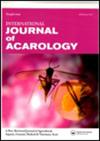土耳其三种植蝇科(Acari:Mesostimata)的新记录和补充描述
IF 1
3区 农林科学
Q3 ENTOMOLOGY
引用次数: 2
摘要
摘要:首次在土耳其报道了三种Phytoseidae(Acari:Mesostimata)、Amblydromalus limonicus(Garman and McGregor)、Neoseulus fauvelli(Athias Henriot)和Typhlodromips sessor(De Leon)。新记录的物种是根据从黑海沿岸萨姆森省的杨树杨属(杨柳科)收集的材料重新描述和说明的。柠檬Amblydromalus limonicus和T.sessor主要产于美洲,是在白杨树和土耳其动物群中意外发现的。第三个物种,Neoseulus fauveli,仅从法国的原始描述中得知。然而,重要的形态学特征,包括背刚毛长度、螯齿列、测量值和腿上巨大刚毛的形状,目前用于区分植物eiid物种,在其原始描述中缺失。在本研究中,N.fauveli在黑杨上的存在并不令人惊讶,因为据报道,新叶杨属的许多其他物种都来自黑杨。本文章由计算机程序翻译,如有差异,请以英文原文为准。
New records and complementary descriptions of three Phytoseiidae (Acari: Mesostigmata) species from Turkey
ABSTRACT Three species of the family Phytoseiidae (Acari: Mesostigmata), Amblydromalus limonicus (Garman and McGregor), Neoseiulus fauveli (Athias-Henriot), and Typhlodromips sessor (De Leon), are reported for the first time from Turkey. The newly recorded species are redescribed and illustrated based on material collected from poplar trees, Populus spp. (Salicaceae), in Samsun Province on the Black Sea coast. Amblydromalus limonicus and T. sessor are mainly known from the Americas and are unexpected findings on poplar trees, as well as in the Turkish fauna. The third species, Neoseiulus fauveli, is known only from its original description from France. However, important morphological features, including dorsal setae lengths, cheliceral dentition, measurements, and the shape of macrosetae on legs, that are currently used to discriminate phytoseiid species, were missing in its original description. The presence of N. fauveli on Populus nigra L. in the present study is not surprising as many other species in the desertus species group of the genus Neoseiulus have been reported from species of Populus.
求助全文
通过发布文献求助,成功后即可免费获取论文全文。
去求助
来源期刊
CiteScore
2.20
自引率
9.10%
发文量
60
审稿时长
6-12 weeks
期刊介绍:
The International Journal of Acarology has a global readership and publishes original research and review papers on a wide variety of acarological subjects including:
• mite and tick behavior
• biochemistry
• biology
• control
• ecology
• evolution
• morphology
• physiology
• systematics
• taxonomy (single species descriptions are discouraged unless accompanied by additional new information on ecology, biology, systematics, etc.)
All submitted manuscripts are subject to initial appraisal by the Editor. If the English is not of a quality suitable for reviewers, the manuscript will be returned. If found suitable for further consideration, it will be submitted to peer review by independent, anonymous expert referees. All peer review is single blind.

 求助内容:
求助内容: 应助结果提醒方式:
应助结果提醒方式:


